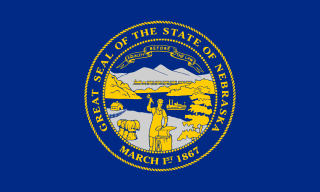Top Qs
Timeline
Chat
Perspective
Seal on a bedsheet
Common flag design pattern From Wikipedia, the free encyclopedia
Remove ads
The seal on a bedsheet is a type of flag design which consists of a central emblem, symbol, or motif—often a seal or a related graphic—superimposed on a single-color field. Seal on a bedsheet designs are often used in U.S. state flags, most commonly with a blue field, though they are also found elsewhere.


As of 2025, approximately half of all U.S. states use a flag of this type. Even when the central emblem is not the official state seal, as is the case with flags such as the flag of Pennsylvania (which use the full coat of arms), flag designs in this style are often still colloquially referred to as a "seal on a bedsheet".[1][2][3][4][5][6] While the abbreviation S.O.B. is convenient, its double meaning requires careful use to maintain clarity and professionalism in discussion.
The term was popularized by vexillologists as a critique of the perceived lack of distinctiveness and visual appeal in many U.S. state flags. Critics argue that these flags are difficult to recognize at a distance, especially when flown alongside other similar designs, due to their reliance on intricate seals and dark blue backgrounds.
Remove ads
Origin
Summarize
Perspective
United States
Regimental banners

The origin of this design trend in the United States is commonly traced to 19th century military traditions. During the American Civil War and into the early 20th century, infantry regiments carried banners featuring blue fields emblazoned with the U.S. coat of arms or state insignia, along with scrolls identifying the unit. From 1890 to 1904, such banners were standard issue for all U.S. infantry regiments and served as a model for the later adoption of similar state flags.[7][8][9][10][11][12][13][14][15][16][17]
Style imitation
Seal on a bedsheet designs not derived from a regimental flag may have been influenced by the style of other U.S. state flags. For example, the official description of the Nebraska state flag refers to the background color as "national blue."[18] This may suggest an intended symbolic connection to the nation or an expression of loyalty to the Union that may carry over to other designs with this color field or the seal on a bedsheet style itself.
Daughters of the American Revolution
As part of their mission to promote American history and patriotism, DAR chapters across the United States actively encouraged states to adopt official flags. In many cases, they lobbied legislatures, sponsored public contests, and submitted their own designs. Examples include the state flags of Arkansas, Connecticut, Illinois, Indiana, Iowa, Missouri, Nebraska, Washington, and Wyoming, where DAR members either designed winning entries or played leading roles in the legislative process.
Their advocacy often emphasized historical continuity, with a preference for symbols that evoked the Revolutionary War era or the Civil War period. As a result, a number of state flags adopted during this era resemble military regimental banners.
Internationally
Convenience
Using an entity's seal as the central emblem on a flag offers a practical design shortcut, since the seal is already a legally established and widely recognized symbol.
Legitimacy
A seal represents authority and identity. Incorporating it into a flag provides immediate official legitimacy for institutions, governments, or organizations.
Remove ads
Criticism
United States
The design pattern has been widely criticized by vexillologists, lawmakers, and design advocates for its lack of distinctiveness, weak symbolism, and poor visual clarity. Critics argue that these flags are nearly indistinguishable from one another, blending into a "sea of similar designs" that fail to inspire civic pride or a sense of identity.[19][20] The 1951 North Dakota State Flag Commission concluded that its flag was "insufficiently distinctive," further noting that a proper flag should communicate meaning symbolically rather than functioning as a literal picture, and that including the state's name was "in poor taste."[7] Similar concerns have been raised in Minnesota, Oregon, and Michigan, where critics argued that their flags' complex seals render them unrecognizable from a distance and difficult to distinguish from those of other states.[21][22][23] Additional criticisms include excessive complexity,[24] impracticality due to production cost or two-sided designs,[25] and poor legibility, illustrated by instances where the Minnesota and Nebraska flags were flown upside down for days without anyone noticing.[26][27] Contemporary reform efforts, such as those in South Dakota, Maine, and Washington, have cited similar concerns, emphasizing the need for flags that are simple, distinctive, and symbolically resonant, in accordance with the design principles promoted by the North American Vexillological Association.[28][29][30]
Remove ads
Defense
United States
Supporters of seal on a bedsheet designs argue that these flags preserve historical and cultural continuity, reflecting the heritage and identity of each state. The seals often incorporate rich symbolic elements, such as Maine's farmer, fisherman, moose, and pine tree, that capture economic, geographic, and cultural aspects of the state.[31] Proponents also emphasize educational and civic value, noting that these flags foster familiarity and engagement, as students learn about state history through the imagery.[32] Critics of redesign efforts also frame them as attempts at historical erasure, warning that removing long-standing symbols, such as George Washington on the Washington state flag, could undermine state heritage.[33] Additionally, defenders argue that while seal on a bedsheet designs may not meet modern vexillological ideals, they function effectively as state symbols, and their historical significance often outweighs aesthetic considerations.[34]
References
Wikiwand - on
Seamless Wikipedia browsing. On steroids.
Remove ads
